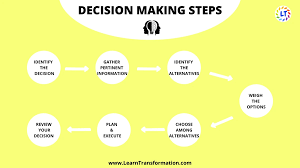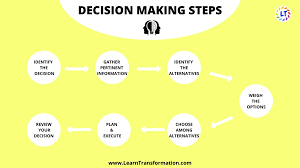Effective Problem Solving and Decision Making Techniques
In our daily lives, we are constantly faced with problems and decisions that require careful thought and consideration. Whether it’s choosing between two job offers, resolving conflicts in relationships, or finding solutions to complex issues at work, having effective problem-solving and decision-making techniques is crucial. Let’s explore some strategies that can help improve these skills.
- Define the problem: The first step in solving any problem is to clearly define what it is. Take the time to identify the root cause and understand the underlying factors contributing to the issue. This will help you focus your efforts on finding appropriate solutions.
- Gather information: Once you have defined the problem, gather as much relevant information as possible. This may involve conducting research, seeking advice from experts or colleagues, or analyzing data. The more information you have, the better equipped you’ll be to make informed decisions.
- Generate alternatives: Brainstorming is an effective technique for generating a wide range of possible solutions. Encourage yourself or your team to think creatively and consider all options, even those that may seem unconventional at first. Remember that quantity is key during this stage; don’t judge ideas prematurely.
- Evaluate options: After generating a list of potential solutions, evaluate each one based on its feasibility, potential outcomes, and alignment with your goals and values. Consider the pros and cons of each option before narrowing down your choices.
- Make a decision: Once you have evaluated all available options, it’s time to make a decision. Trust your instincts but also rely on logical reasoning and objective analysis. Consider seeking input from others who may provide valuable perspectives.
- Implement the solution: After making a decision, develop an action plan for implementing your chosen solution effectively. Break down tasks into manageable steps with clear timelines and responsibilities assigned to each team member if applicable.
- Monitor progress: Continuously monitor the progress of your solution implementation. Evaluate whether it is achieving the desired results and make adjustments as necessary. Be open to feedback and adapt your approach if needed.
- Learn from the process: Problem-solving and decision-making are iterative processes. Take the time to reflect on what worked well and what could be improved for future situations. Learning from past experiences will help you refine your skills over time.
Remember, effective problem solving and decision making require practice and patience. By employing these techniques consistently, you can enhance your ability to tackle challenges with confidence and achieve optimal outcomes in various aspects of your life.
Frequently Asked Questions: Effective Problem Solving and Decision Making Techniques
- What are the 7 problem-solving techniques?
- What are problem and problem-solving techniques?
- What are the 5 processes for making decisions and solving problems?
- What are effective decision-making techniques?
What are the 7 problem-solving techniques?
There are several problem-solving techniques that can be effective in different situations. Here are seven commonly used techniques:
- Brainstorming: This technique involves generating a large number of ideas and potential solutions without judgment or criticism. It encourages creativity and opens up possibilities that may not have been considered initially.
- Root Cause Analysis: This technique focuses on identifying the underlying causes of a problem rather than just addressing the symptoms. By understanding the root cause, you can develop more targeted solutions that address the core issue.
- SWOT Analysis: SWOT stands for Strengths, Weaknesses, Opportunities, and Threats. This technique involves evaluating these four aspects to gain a comprehensive understanding of a situation or problem. It helps in identifying potential advantages and disadvantages, as well as external factors that may impact decision making.
- Decision Matrix: A decision matrix is a structured approach to evaluate multiple options based on specific criteria or factors. It involves assigning weights to each criterion and rating each option accordingly, resulting in a quantitative analysis that aids decision making.
- Pareto Analysis: Also known as the 80/20 rule, Pareto analysis helps prioritize problems by focusing on the most significant ones that will yield the most substantial impact when addressed. It involves identifying and addressing the vital few issues that contribute to the majority of problems.
- Fishbone Diagram: A fishbone diagram, also called an Ishikawa diagram or cause-and-effect diagram, is used to identify potential causes of a problem by visually mapping out various contributing factors and their relationships.
- Six Thinking Hats: Developed by Edward de Bono, this technique involves looking at a problem from six different perspectives represented by colored “hats.” Each hat represents a specific thinking style (e.g., logical thinking, creative thinking) and encourages exploring various angles to generate well-rounded solutions.
These techniques provide structured approaches to problem solving, helping individuals or teams effectively analyze problems and make informed decisions. Choosing the most suitable technique depends on the nature of the problem and the desired outcome.
What are problem and problem-solving techniques?
A problem can be defined as a situation or challenge that needs to be resolved or addressed. It is an obstacle or discrepancy between the current state and the desired state. Problems can arise in various aspects of life, such as personal relationships, work environments, or even within oneself.
Problem-solving techniques are systematic approaches used to identify, analyze, and resolve problems effectively. These techniques help individuals or teams navigate through complex situations and find suitable solutions. Here are some commonly used problem-solving techniques:
- Root Cause Analysis: This technique involves identifying the underlying cause of a problem by asking “why” repeatedly until the core issue is revealed. By addressing the root cause, you can prevent similar problems from occurring in the future.
- Brainstorming: Brainstorming is a creative technique that encourages generating a large number of ideas without judgment. It allows for diverse perspectives and promotes innovative thinking to find potential solutions.
- SWOT Analysis: SWOT stands for Strengths, Weaknesses, Opportunities, and Threats. This technique involves evaluating these four factors to assess a situation comprehensively and develop strategies accordingly.
- Decision Matrix: A decision matrix helps evaluate multiple options by assigning weights to different criteria and scoring each option accordingly. This systematic approach helps in making objective decisions based on predetermined factors.
- Fishbone Diagram: Also known as a cause-and-effect diagram or Ishikawa diagram, this technique visually represents all possible causes contributing to a problem. It helps identify potential sources of an issue and provides insights into where improvements can be made.
- 5 Whys: Similar to root cause analysis, the 5 Whys technique involves asking “why” repeatedly until you reach the fundamental cause of a problem. By exploring multiple layers of causality, you can gain deeper insights into the issue at hand.
- Pareto Analysis: The Pareto principle states that roughly 80% of effects come from 20% of causes. Pareto analysis involves identifying and prioritizing the most significant contributing factors to a problem, allowing you to focus efforts on the vital few rather than the trivial many.
- Decision Trees: Decision trees are graphical representations that help visualize different decision paths and potential outcomes. They provide a structured framework for analyzing choices and their consequences, aiding in making informed decisions.
These problem-solving techniques can be used individually or in combination, depending on the nature and complexity of the problem at hand. By employing these approaches, individuals and teams can enhance their problem-solving skills and increase their chances of finding effective solutions.
What are the 5 processes for making decisions and solving problems?
There are various models and frameworks for decision making and problem solving, but one commonly used approach is the five-step process. Here are the five processes involved:
- Define the problem: The first step is to clearly identify and define the problem or challenge. This involves understanding the symptoms, underlying causes, and any constraints or limitations that may impact the solution.
- Gather information: Once the problem is defined, gather relevant information about it. This may involve conducting research, collecting data, seeking expert opinions, or consulting with others who have faced similar issues. The goal is to gather as much information as possible to make an informed decision.
- Generate alternatives: Brainstorm a range of possible solutions or alternatives to address the problem. Encourage creativity and consider all options without judgment at this stage. The more alternatives you generate, the greater your chances of finding an effective solution.
- Evaluate options: Evaluate each alternative based on criteria such as feasibility, potential outcomes, risks involved, and alignment with goals and values. Consider both qualitative and quantitative factors when comparing options. This step helps narrow down the alternatives to a smaller set of viable choices.
- Make a decision: After evaluating all available options, make a decision by selecting the best choice that aligns with your objectives and preferences. Consider all relevant factors, including risks and potential consequences. Trust your judgment while also considering input from others if necessary.
It’s important to note that decision making and problem solving are iterative processes, meaning you may need to revisit earlier steps if new information emerges or if your initial solution doesn’t yield desired results. Flexibility and adaptability are key throughout this process.
By following these five processes consistently, you can enhance your ability to make effective decisions and solve problems in various personal and professional contexts.
What are effective decision-making techniques?
Effective decision-making techniques can vary depending on the situation and the complexity of the decision at hand. However, here are some commonly used techniques that can help improve your decision-making skills:
- Rational Decision Making: This technique involves a systematic approach that relies on logic and analysis. It includes identifying the problem, gathering relevant information, evaluating alternatives, weighing pros and cons, and making a logical choice based on objective criteria.
- SWOT Analysis: SWOT stands for Strengths, Weaknesses, Opportunities, and Threats. This technique involves assessing these four factors to evaluate a decision’s potential outcomes. By understanding the internal strengths and weaknesses of a situation and considering external opportunities and threats, you can make more informed decisions.
- Decision Matrix: A decision matrix is a tool that helps evaluate multiple options against specific criteria or factors. By assigning weights or scores to different criteria based on their importance, you can objectively compare alternatives and choose the one that best meets your desired outcomes.
- Pareto Analysis: Also known as the 80/20 rule, Pareto analysis focuses on identifying the vital few factors that have the most significant impact on a decision’s outcome. By prioritizing these critical factors, you can allocate your resources effectively and make decisions with maximum impact.
- Six Thinking Hats: Developed by Edward de Bono, this technique involves wearing different “hats” representing different thinking styles (e.g., logical thinking, creative thinking, emotional thinking) to explore a problem from multiple perspectives. This approach encourages comprehensive analysis before making a decision.
- Deliberation with Stakeholders: In situations where decisions affect multiple stakeholders or where diverse perspectives are valuable, involving relevant parties in deliberation can lead to better outcomes. By seeking input from individuals with different backgrounds or expertise, you can gain valuable insights and consider various viewpoints before making a final decision.
- Intuition and Gut Feeling: Sometimes our subconscious mind can provide valuable insights that logic alone may not capture. Trusting your intuition or gut feeling can be a valid decision-making technique, especially when you have relevant experience or expertise in the subject matter.
Remember, no single technique guarantees a perfect decision every time. It’s essential to adapt and choose the technique that best suits the situation and aligns with your decision-making style. Practice, experience, and continuous learning will help you refine your decision-making skills over time.



